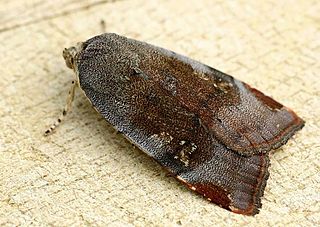Related Research Articles

The large yellow underwing is a moth, the type species for the family Noctuidae. It is an abundant species throughout the Palearctic realm, one of the most common and most familiar moths of the region. In some years the species is highly migratory with large numbers appearing suddenly in marginal parts of the range.

Atethmia centrago is a moth of the family Noctuidae. It is found in Europe except Scandinavia and Italy; also in Asia Minor, Armenia, Syria and Palestine.

Noctua janthe, the lesser broad-bordered yellow underwing, is a moth of the family Noctuoidea. Some authors consider Noctua janthe and Noctua janthina to be the same species. It is found in Europe and North Africa.

Noctua interjecta, the least yellow underwing, is a species of moth of the family Noctuoidea. It is found in Europe.

Ipimorpha subtusa, the olive, is a moth of the family Noctuidae. It is found in the Palearctic realm.

Hoplodrina ambigua, the Vine's rustic, is a moth of the family Noctuidae. It is found in the western Palearctic realm.

Cucullia chamomillae, the chamomile shark, is a species of moth of the family Noctuidae. It is found in Central Europe, Southern Europe, the Near East and North Africa.

Xanthia togata, the pink-barred sallow, is a species of moth of the family Noctuidae. It is a Holarctic species, and is found throughout Europe and east through the Palearctic to Central Asia, and Siberia up to the Ussuri. The distribution area includes the United States and Canada. It was first described by the German entomologist Eugenius Johann Christoph Esper in 1788 from the type specimen in Germany

Xylena exsoleta, the sword-grass, is a species of moth of the family Noctuidae.

Diaphora mendica, the muslin moth, is a moth of the family Erebidae. It is found in the Palearctic realm east to Lake Baikal.

Spilosoma lubricipeda, the white ermine, is a moth of the family Erebidae. It is found throughout the temperate belt of Eurasia from Europe through Kazakhstan and southern Siberia to Amur Region, China, Korea and Japan. In China several sibling species occur.

Noctua fimbriata, the broad-bordered yellow underwing, is a moth of the family Noctuidae. It is found in Europe, North Africa, Anatolia, the Caucasus, Turkey, Caucasus, Transcaucasia, Armenia, Turkmenistan and Novosibirsk Oblast. The border of its southern range is unclear because of the similar looking species Noctua tirrenica.

Setina irrorella, the dew moth, is a moth of the family Erebidae. The species was first described by Carl Linnaeus in his 1758 10th edition of Systema Naturae. It is found in the Palearctic from Ireland, then through Europe and east to northern and central Asia to the Pacific Ocean. It is missing in the high north and parts of the Mediterranean region. It is found also in the limestone Alps up to 2,000 meters above sea level.

Spilosoma eldorado is a moth of the family Erebidae. It was described by Walter Rothschild in 1910. It is found in eastern India and Sri Lanka.
Agrioceros hypomelas is a moth in the family Depressariidae. It was described by Alexey Diakonoff in 1966. It is found on Sulawesi.
Agrioceros neogena is a moth in the family Depressariidae. It was described by Alexey Diakonoff in 1966. It is found on the Selayar Islands.
Agrioceros subnota is a moth in the family Depressariidae. It was described by Alexey Diakonoff in 1966. It is found on Java.
Agrioceros platycypha is a moth in the family Depressariidae. It was described by Edward Meyrick in 1928. It is found in the Philippines.
Agrioceros zelaea is a moth in the family Depressariidae. It was described by Edward Meyrick in 1906. It is found in Sri Lanka.
Ethmia submersa is a moth in the family Depressariidae. It was described by Alexey Diakonoff in 1966. It is found on Sulawesi.
References
- ↑ Beccaloni, G.; Scoble, M.; Kitching, I.; Simonsen, T.; Robinson, G.; Pitkin, B.; Hine, A.; Lyal, C., eds. (2003). "Agrioceros magnificella". The Global Lepidoptera Names Index . Natural History Museum . Retrieved May 19, 2018.
- ↑ Agrioceros at funet
- ↑ Reisen Archipel. Philipp. 2 : 700
| This article on a moth of the subfamily Ethmiinae is a stub. You can help Wikipedia by expanding it. |